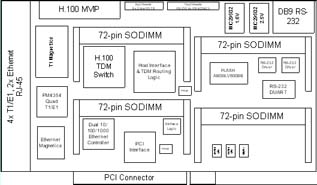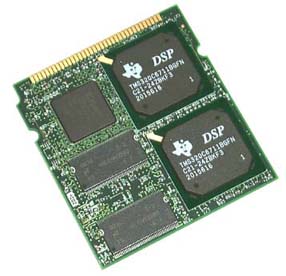Home :: System Integration
:: Communications :: Radar
:: Multiprocessor Floating-Point DSP :: SigC67xx-PCI
SigC67xx-PCI Multiple DSP and Analog / Telephony I/O BoardBoard no longer recommended for new designs; please see the following alternatives instead SigC67xx-PCI Multiple DSP and Telephony/Analog I/O Board
OverviewThe SigC67xx-PCI board uses a modular approach to provide up to 5 GFLOPS in a single PCI card slot. The board accepts modules with Texas Instruments C67xx DSP processors and modules with 16-bit audio and speech analog I/O. It is suitable for embedded telecom and Internet infrastructure applications where space is at a premium. Applications for SigC67xx modules include radar, sonar, control systems, medical, cellular base station, high precision FFT, wavelet, and other transform processing, VoIP (voice-over Internet protocol) processing, networking functions, VoDSL (voice-over DSL), Internet routing, multiple-channel speech or audio code / decode (e.g. G.729A or MELP speech compression and MP3 audio compression), modem banks, echo cancellation, and speech recognition. The modular approach is particularly well suited to providing a scalable solution for defense electronics, telecom, and Internet equipment applications that require a high number of DSP devices. For example, channel capacity is highly configurable. SigC67xx-PCI Feature Summary
Specifications and Data SheetsProcessorsThe Texas Instruments C67xx 32-bit floating-point DSP family offers high performance, a flexible external memory interface, and a rich set of onchip peripherals. The TMS320C6711, C6712, and C6713 digital signal processors range from 160 to 225 MHz (400 to 625 true MFLOPS) in processing capability. They offer a complete set f onchip peripherals depending on processor type, including serial ports, host port, PLL, timers, DMA channels, and up to 128k x 32 onchip memory. Cost/performance tradeoff possibilities range from the C6711, an extremely cost effective solution, to higher performance processors, such as the C6713. Host PC InterfaceThe host PC interface is through a PLX 9056 non-transparent bridge device, and supports both bus master and slave transfers. Host software can access multiple C67xx HPIs, quad T1/E1 interface, serial/TDM routing PLD, boot/FLASH EEPROM, RS-232 DUART, and internal PLD registers. The HPI interface allows host software to view onchip C67xx memory as dual-access and fully supports multiplexed-mode HPI features, such as auto-increment. This method allows efficient data transfers between host PC software and the SigC67xx-PCI board while the processors continue to run, and fully complies with DirectDSP software support. Multiple C67xx HPIs can be accessed simultaneously by the host during write transfers; for example, COFF files can be downloaded to any combination of DSPs simultaneously. Using the DirectDSP software interface, C67xx processors do not need to be held or otherwise delayed when host software accesses onchip SRAM, and DSP source code does not need to be altered or "instrumented" in any way. The DirectDSP software interface to multiple DSPs is complimentary to JTAG debugging tools such as Code Composer Studio software, and may be used at the same time. DirectDSP software provides Plug-N-Play compatible Win9x and WinXP drivers. An I2C serial "cookie data" EEPROM provides the PLX 9056 PCI interface bridge with hardware configuration, product and vendor type, firmware version, and other board information. Analog I/OCombined with SigC67xx processor modules, the
SigSD4-SODIMM Audio Module
offers multichannel 16-bit sigma-delta analog I/O as an integrated component in the modular solution.
Audio Module features include:
sigma-delta converters that provide sharp anti-alias and reconstruction
filter roll-off, and nearly linear phase response sampling rates and filter cutoff frequencies are software programmable;
all channels are sampled simultaneously TDM (time division multiplex) serial output allows distribution of multichannel
audio data to one or more DSP processors; audio data can be replicated among processors, or distributed uniformly, as needed analog input/output signals are routed directly to the module using a
small-outline Mictor 38-pin connector that supports individually shielded conductors The SigC67xx-PCI board provides four (4) synchronous serial channels and two (2) RS-232 asynchronous serial channels. All serial I/O signals are available at board edge; routing is software-programmable and levels are software-programmable for either RS-422 or RS-423 (balanced or unbalanced). T1/E1 Quad Telephony InterfaceThe SigC67xx-PCI board contains a PMC Sierra PM4354 quad T1/E1 device with integrated framers and transceivers that provides a telephony interface available on both a standard MVIP H.100 connector and four (4) RJ-45 connectors (located at the board backplate, using RJ-48C electrical wiring specification). In addition to the RJ-45 connectors, the telephony interface includes onboard magnetics and activity/status indicators (LEDs). Command, control, and status information is available to the host interface, and all TDM data is routed to the DSP module sites, via the programmable PLD switch matrix. Dual 10/100/1000 Ethernet InterfaceThe SigC67xx-PCI board contains a PMC Sierra PM3386 dual 10/100/1000 Mbps Ethernet device, and provides external interface on two (2) RJ-45 headers at the board backplate. In addition to the RJ-45 connectors, the Ethernet interface includes onboard transceivers, magnetics and activity/status indicators (LEDs built into the RJ-45 connectors). POTS Telephony InterfaceThe SigC67xx-PCI contains 2x quad-SLAC devices (2x "QSLAC" devices) and 8x SLIC devices and associated circuitry, to allow connection to four (4) sets of 2-line POTS connections (8 POTS lines total). Magnetics and RJ-11 connectors are not located on the board; instead, 8x2 dual inline headers are provided at the top of the board for ribbon cable connection to four (4) external RJ-11 connectors Command, control, and status and all TDM data are routed to the DSP module sites, via the programmable PLD switch matrix. TDM Routing PLDThe SigC67xx-PCI board contains an onboard PLD logic device that allows flexible serial port/TDM routing capabilities. For example, PLD logic is used to multiplex both quad SLAC devices into a single TDM stream to fit the natural architecture of the C67xx DSP families and facilitate DSP software development. As another example, the PLD logic allows quad T1/E1 data to be routed to any combination of DSP module sites. Boot/FLASH EEPROMThe SigC67xx-PCI board contains a 1M x 8 boot/FLASH EEPROM device site for storage of boot code and nonvolatile application data. Using the EEPROM for program code storage, the board also supports a "power only", or stand-alone mode of operation. SigC67xx-PCI Software SupportThe SigC67xx-PCI card, as well as other C67xx platforms such as the Texas Instruments DSK C5402 board, are supported by Signalogic off-the-shelf DSP software products designed for DSP-based real-time processing and C67xx DSP code development, including:
|





